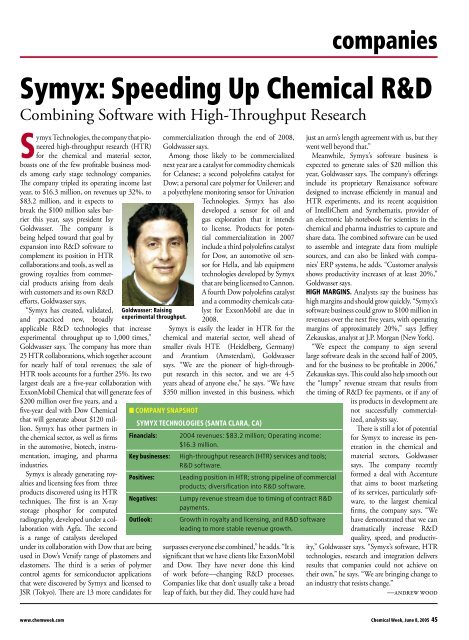Chemical Week
Chemical Week
Chemical Week
You also want an ePaper? Increase the reach of your titles
YUMPU automatically turns print PDFs into web optimized ePapers that Google loves.
Symyx: Speeding Up <strong>Chemical</strong> R&DCombining Software with High-Throughput ResearchSymyx Technologies, the company that pioneeredhigh-throughput research (HTR)for the chemical and material sector,boasts one of the few profitable business modelsamong early stage technology companies.The company tripled its operating income lastyear, to $16.3 million, on revenues up 32%, to$83.2 million, and it expects tobreak the $100 million sales barrierthis year, says president IsyGoldwasser. The company isbeing helped toward that goal byexpansion into R&D software tocomplement its position in HTRcollaborations and tools, as well asgrowing royalties from commercialproducts arising from dealswith customers and its own R&Defforts, Goldwasser says.“Symyx has created, validated,and practiced new, broadlyapplicable R&D technologies that increaseexperimental throughput up to 1,000 times,”Goldwasser says. The company has more than25 HTR collaborations, which together accountfor nearly half of total revenues; the sale ofHTR tools accounts for a further 25%. Its twolargest deals are a five-year collaboration withExxonMobil <strong>Chemical</strong> that will generate fees of$200 million over five years, and afive-year deal with Dow <strong>Chemical</strong>that will generate about $120 million.Symyx has other partners inthe chemical sector, as well as firmsin the automotive, biotech, instrumentation,imaging, and pharmaindustries.Symyx is already generating royaltiesand licensing fees from threeproducts discovered using its HTRtechniques. The first is an X-raystorage phosphor for computedradiography, developed under a collaborationwith Agfa. The secondis a range of catalysts developedunder its collaboration with Dow that are beingused in Dow’s Versify range of plastomers andelastomers. The third is a series of polymercontrol agents for semiconductor applicationsthat were discovered by Symyx and licensed toJSR (Tokyo). There are 13 more candidates forGoldwasser: Raisingexperimental throughput.commercialization through the end of 2008,Goldwasser says.Among those likely to be commercializednext year are a catalyst for commodity chemicalsfor Celanese; a second polyolefins catalyst forDow; a personal care polymer for Unilever; anda polyethylene monitoring sensor for UnivationTechnologies. Symyx has alsodeveloped a sensor for oil andgas exploration that it intendsto license. Products for potentialcommercialization in 2007include a third polyolefins catalystfor Dow, an automotive oil sensorfor Hella, and lab equipmenttechnologies developed by Symyxthat are being licensed to Cannon.A fourth Dow polyolefins catalystand a commodity chemicals catalystfor ExxonMobil are due in2008.Symyx is easily the leader in HTR for thechemical and material sector, well ahead ofsmaller rivals HTE (Heidelberg, Germany)and Avantium (Amsterdam), Goldwassersays. “We are the pioneer of high-throughputresearch in this sector, and we are 4-5years ahead of anyone else,” he says. “We have$350 million invested in this business, which■ COMPANY SNAPSHOTSYMYX TECHNOLOGIES (SANTA CLARA, CA)Financials:Key businesses:Positives:Negatives:Outlook:2004 revenues: $83.2 million; Operating income:$16.3 million.High-throughput research (HTR) services and tools;R&D software.Leading position in HTR; strong pipeline of commercialproducts; diversification into R&D software.Lumpy revenue stream due to timing of contract R&Dpayments.Growth in royalty and licensing, and R&D softwareleading to more stable revenue growth.surpasses everyone else combined,” he adds. “It issignificant that we have clients like ExxonMobiland Dow. They have never done this kindof work before—changing R&D processes.Companies like that don’t usually take a broadleap of faith, but they did. They could have hadcompaniesjust an arm’s length agreement with us, but theywent well beyond that.”Meanwhile, Symyx’s software business isexpected to generate sales of $20 million thisyear, Goldwasser says. The company’s offeringsinclude its proprietary Renaissance softwaredesigned to increase efficiently in manual andHTR experiments, and its recent acquisitionof IntelliChem and Synthematix, provider ofan electronic lab notebook for scientists in thechemical and pharma industries to capture andshare data. The combined software can be usedto assemble and integrate data from multiplesources, and can also be linked with companies’ERP systems, he adds. “Customer analysisshows productivity increases of at least 20%,”Goldwasser says.HIGH MARGINS. Analysts say the business hashigh margins and should grow quickly. “Symyx’ssoftware business could grow to $100 million inrevenues over the next five years, with operatingmargins of approximately 20%,” says JeffreyZekauskas, analyst at J.P. Morgan (New York).“We expect the company to sign severallarge software deals in the second half of 2005,and for the business to be profitable in 2006,”Zekauskas says. This could also help smooth outthe “lumpy” revenue stream that results fromthe timing of R&D fee payments, or if any ofits products in development arenot successfully commercialized,analysts say.There is still a lot of potentialfor Symyx to increase its penetrationin the chemical andmaterial sectors, Goldwassersays. The company recentlyformed a deal with Accenturethat aims to boost marketingof its services, particularly software,to the largest chemicalfirms, the company says. “Wehave demonstrated that we candramatically increase R&Dquality, speed, and productivity,”Goldwasser says. “Symyx’s software, HTRtechnologies, research and integration deliversresults that companies could not achieve ontheir own,” he says. “We are bringing change toan industry that resists change.”—ANDREW WOODwww.chemweek.com <strong>Chemical</strong> <strong>Week</strong>, June 8, 2005 45
















